The Benefits of e-Commerce Solutions and What It Takes to Build One

E-commerce has been driven by the implementation of 4G and 5G technology, the growing adoption of smartphones, social media applications that increase the users’ exposure to online shopping, proliferating small and medium businesses and increasing consumer wealth in developing economies, and other factors. Large enterprises have also been increasingly leaning towards online business. The global e-commerce market size was expected to grow at a compound annual growth rate of 14.7% from 2020 to 2027.
COVID-19 has given e-commerce a major boost. According to the latest Digital Commerce 360 analysis, in 2020, consumers spent 861.12 billion dollars online with U.S. retailers, up 44% from the year prior. Online spending represented 21.3% of total retail sales, compared with 15.8% in 2019. In 2021, the U.S. retail e-commerce market size should exceed $400 billion.
The number of digital buyers is expected to exceed 2.14 billion worldwide this year, up from 1.66 billion in 2016.
Despite the high competition in the industry, there is still space for new players. For entrepreneurs that are contemplating their own online store or marketplace, this article should offer some tips regarding e-commerce website development.
For those who are not convinced by e-commerce growth statistics, here are more reasons to make your own website.
The Potential Benefits of E-commerce Solutions
- An easier reach for a wider pool of customers and the necessary exposure to other businesses are the primary benefits of e-commerce to business owners that are only starting, expanding an existing business, or giving it a fresh start.
The majority of consumers nowadays start product searches online, primarily on mobile phones. Without an online presence, they wouldn’t learn about a company’s goods or services. In contrast, the power of digital marketing combined with search engine optimization (SEO) creates tremendous opportunities for sales and growth.
- E-commerce links sellers and buyers regardless of their geographical location. The opportunities to endorse a company’s products and services become boundless.
- The cost of building and maintaining an online store is much lower compared with the cost of opening a physical storefront.
- An online platform enables consumers to shop and companies to run sales round-the-clock.
- Businesses can also receive and quickly respond to customers’ questions and requests, improving customer service, customer loyalty, and retention.
- Process automation is another great advantage. E-commerce platforms with integrated billing and delivery service APIs make it possible to prepare an invoice and delivery note in two clicks. An admin panel facilitates the management of product stock and keeping the descriptions, pictures, names, categories, etc., up to date.
- Online sales help cut expenditure in communication and infrastructure even for big established companies.
- The system collects data about the customers, orders, stock, etc., empowering businesses to access statistics and discover trends. This helps build strategies and adjust their marketing and sales efforts to maximize profits.
- When customers don’t have to travel to a physical store and browse among the goods there, they save time and money. A smart business can convince them to spend those saved resources on extra online purchases.
- The use of innovations, such as artificial intelligence (AI), chatbots, augmented and virtual reality (AR and VR), facilitates conversions, sales, and hence businesses’ growth.
The potential benefits of e-commerce for your business may be plentiful, but starting an online store requires consideration, research, calculations, planning, and a basic understanding of e-commerce website development. Let’s take it step by step.
Things to Consider before Building E-commerce Site
Generally, the e-commerce website development process encompasses the following activities:
- Discovery phase
- User experience and user interface (UX and UI) design
- Web back-end and front-end development
- Quality assurance (QA)
- Ongoing support and development
Before launching an e-commerce, the business owner should consider both the market potential and their own capabilities, e.g., their website development budget. This roughly corresponds to the discovery phase.
It all starts with your business goals. First of all, it’s necessary to determine your preferred type of website:
- E-commerce store – an online commerce solution for selling a company’s products or services, typically of a limited range; or
- E-commerce marketplace – a whole platform hosting many sellers that is focused on wholesale and mass retail.
If it’s a marketplace, there are several e-commerce business models you might go for:
- Business to consumer (B2C). Goods or services are sold straight from businesses to the general public without involving any third parties. The customers use an online catalog, pick items for purchase, and check out virtually. Amazon and Flipkart are examples of B2C online shops.
- Business to business (B2B). The sales of goods or services happen between businesses through an online sales portal. This model is generally used to enhance a company’s sales efforts. The seller may be a manufacturer, a wholesaler, or a provider within a given industry, e.g., outsourcing services, particular equipment distribution, etc. Alibaba.com is a B2B online commercial center.
- Customer to customer (C2C). This marketplace enables people to sell or exchange goods or services. eBay and Etsy are C2C ecommerce websites.
- Consumer to business (C2B). This business model involves freelancers that perform jobs offered by the clients, mostly corporate entities. Remember Upwork as an example.
- Price comparison (aggregator) websites. These vertical search engines help users filter and compare products from vendors’ websites based on features, price, reviews, etc., and purchase the best deal.
- Auction (bidding) e-commerce websites. On these websites, products are enlisted for auction, and users place their bids to procure those items.
Every e-commerce project should be guided by research about the products or services that will be sold and the people who will buy them. Begin the description of your solution with answers to the following questions:
- What are you going to sell, and in what amounts or numbers? (It may be something you are passionate about, something that is in high demand or missing in the market, and so forth.)
- Which particular market niche is most relevant for you (e.g., where you have the most experience, or where your product fits best)?
- What problem or problems are you going to solve for the consumers and businesses (if applicable)?
- Which demographic group(s) primarily need, or will be interested, and will be able to spend money on your website?
Put down several SMART goals that the e-commerce site should achieve for your business.
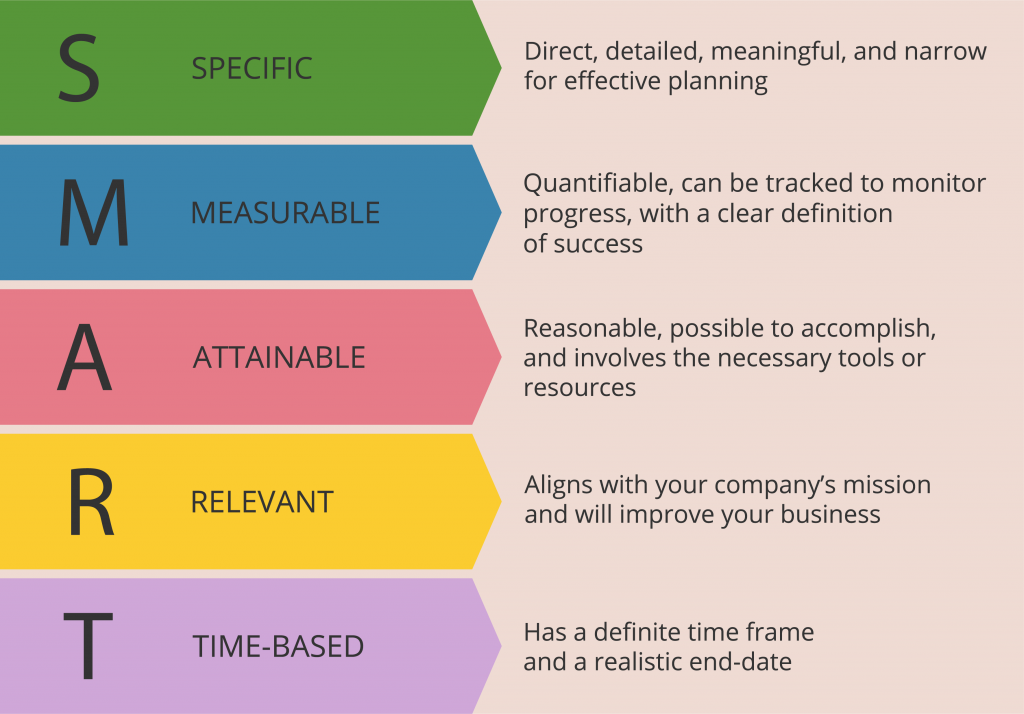
All this will give you the basic concept of your future solution and the project scale. Now you can start your research, potential competition, and target market analysis. For example, after defining the products or services you are going to offer, you can identify other online shops selling them.
It’s essential to know the market you’re entering, what products sell successfully, and the market’s past and current trends.
What is a target market analysis? You will basically study your potential customers. You need to know what your target audience (TA) needs right now, what they may want in the future, and how to satisfy them best.
The understanding of your potential customers permeates every stage of the e-commerce website development process. Everything must be tailored to meet their needs and expectations: the user experience and user interface, the site’s visuals, content, and even the products’ specs.
Every detail you learn about your TA may help provide a better UX and build a stronger personal connection with customers. Knowing their age, gender, background, geography, culture, income range, tastes, favorite gadgets, purchasing inclinations, and other facts, you will be able to prioritize your groups of users and develop the site design, product categories, descriptions, images, payment gateways, and other aspects more effectively.
Describe your buyer persona in detail. Questionnaires are a good instrument for discovering the necessary information. If people are already buying your product offline, start with interviewing them. Ask about their needs and any problems with the current shopping, what other websites they purchase from, what they like and dislike about it, how much they spend, and so forth.
E-commerce competitor analysis is equally important. Your odds of success are extremely low if you intend to compete with big players possessing popular services and impressive marketing budgets. Finding a niche with some breathing room can give you a better chance, especially if you have a unique idea for processes, branding, and customer experience.
The easiest way to search for competitors in your niche is to browse the web indexes utilizing relevant catchphrases. Instruments like Semrush also help analyze the most relevant keywords indicating demand, discovering potential rivals, and identifying the most active and ready-to-buy TAs. Looking at other companies’ rates, you can also see how well and in what numbers you can expect to sell your products. For more in-depth e-commerce market research and analysis, it’s generally recommended to hire experts.
Regardless of your methods, it’s always worthwhile to explore the competitors’ websites to study their user experience, pricing strategies, purchase funnels, promotional schemes, marketing tools, and communication with their audiences via social media. It’s even better to gain first-hand experience by ordering something. List the websites’ useful features, advantages, and drawbacks, and try to figure out what could set you apart.
It’s also useful to study each website’s technical framework, hosting platform, domain name, content management system (CMS), and other add-ons they use to run and advertise their online stores. These details may help you make some crucial choices when it comes to building an e-commerce site for your business.
Knowing your TA’s tastes and the competition is essential even for choosing or creating your website name. It should be concise, original, but easy to remember and distinguish your brand from competitors. A unique name also means better odds of getting a perfect e-commerce domain name. If you can’t find an available URL including the iconic .com, you might try .biz, .shop, .solutions, .online, or other domains that can work as well.
NB. Once you’ve got a business name and found an available URL, go ahead and register the domain name lest someone else snatches it up while you are developing your website.
Once you have worked out your business idea and requirements for the future e-commerce solution, you are ready to reach out to the professionals that can implement it. To qualify for the job, vendors should have positive reviews and a strong track record of building ecommerce sites. Ideally, they should also provide UX/UI design services, offer ongoing support, and be ready to advise you before your actual cooperation begins.
Namely, you will likely need advice on prioritizing your future ecommerce website features, most suitable technologies, project planning, and other prerequisites of successful and cost-effective software development.
Firstly, the experts can help you decide on the format of your solution. Depending on the results of your research, available budget, and ambitions, you may choose among several scenarios:
- Basic website. It can be initially limited to several simple web pages and the bare minimum of functionalities (to be expanded later). It’s even possible to build single-handedly, using an off-the-shelf template (to be discussed further in the article).
- Specialized resource. Often, business owners take a readymade template but hire web developers to customize it, e.g., to change the look and add interactive elements, marketing tools, and so on.
- Custom-built online shop. This implies another level of user experience and helps a business stand out from the crowd. The owner can implement an authentic look and various features to meet their unique business and end-users needs. This is a pricier yet totally affordable option.
- Full-on online enterprise. This includes maximum security and sophisticated features aiming at mass audiences, selling top-end products or services, eliminating all competitors, and so forth. Such custom ecommerce website development will require a considerable budget.
Alternative-spaces typically recommends its clients start with a minimum viable product (MVP). This is a practical way to validate your assumptions and test the market interest quickly and at a minimum cost. Within a few weeks, a couple of programmers can build and launch an MVP marketplace or store that can effectively sell goods or services to real customers.

By monitoring the early users’ feedback and key performance indicators (KPIs), including the sales, you will be able to assess the effectiveness of the platform and chosen solutions, the user experience, and more. Then, you may either make adjustments and develop the website further, or pivot, or close the project.
The development of your MVP or a full-fledged online commerce platform will proceed faster if your team utilizes one of the specialized web development platforms. This topic deserves special attention.
Custom E-commerce Development or Website Builders?
The primary benefits of e-commerce development using website builders and templates are:
- Lower upfront development costs
- Shorter time-to-market period
The disadvantages include:
- Often, a limited range of provided functionality
- The result is a generic product
- Off-the-shelf templates or themes may offer little room for customization and unique design ideas
- Bottlenecks while building an ecommerce site and inability to scale an online business
- Their marketing and SEO capabilities may be limited and not suited for a particular business
- High monthly fees, so costs can accumulate over time, especially if you want to scale your site later on
- You will still incur expenses like hosting, domain, extra themes, plugins, development, etc.
Still, such platforms are an excellent solution for small and mid-sized sites that don’t harbor plans for extensive scalability, employing new technologies, or innovation. Even free plans empower entrepreneurs to set up a basic store and start selling products online immediately. If they build a simple templated solution, the platform provider will handle most testing and maintenance. For greater capabilities, store owners will need certain skills and investments into premium plans and underlying software.
Some of the leading e-commerce website builders are:
Shopify
Over one million business clients across 175 countries are using this e-commerce solution. It is best geared towards small-to-medium businesses (SMB), especially boutiques and exclusive product stores.
With various features already integrated, it’s virtually possible to make an e-commerce website single-handedly. Shopify has diverse custom domains, AI personalization, over 70 user-friendly templates, extensive SEO features, and excellent 24/7 support.
Shopify Lite, with certain limitations, costs $9/month; Basic Shopify will cost $29/month. There will also be an additional fee for each sale you make.
WooCommerce
A quarter of all online stores use this free, open-source shopping cart plugin. WooCommerce is perfect for small businesses that already have a WordPress site but also a modest budget.
The features include shipping options, calculator, geolocation support, mobile optimization, coupons, and discounts. However, since you may need to buy additional extensions to implement more features, your e-commerce site cost will depend on their number and complexity.
OpenCart
This platform is also open-source and free and can be integrated with your existing website. Although not the best fit for large-scale projects, OpenCart offers everything you may need to run an online store: unlimited item categories, accessible dashboard, numerous themes, and plugins. Various modules, extensions, and themes will help you customize its look-and-feel. There’s also excellent documentation, a helpful online community, and paid technical support.
OpenCart’s self-hosted version is free; the cost of a cloud-hosted version starts at $30.
3dcart
This all-in-one platform is specially focused on digital marketing. For example, there are built-in integrations with MailChimp, AWeber, Google, Facebook, Houzz, and more. All plans include a shopping cart, unlimited orders, over 50 mobile-ready themes, domain registration, secure web hosting, and other features, as well as 24×7 support.
The pricing starts from $29/month for the basic store plan, but there are no transaction fees.
Magento
Magento is equally well-suited for big stores and SMBs with sufficient human resources to set up their website and value the ability to evolve into a marketplace eventually. The platform offers tons of features and adjustments, themes, and plugins. Its features include global selling optimized for mobile shopping, instant purchase, video options available for customization, and more. A great community will help you figure out all the nuances.
Three versions are available: Magento Open Source is free, while Commerce and Commerce Cloud are paid solutions. Online store owners will need to spend at least $18,000 per year; further costs will depend on their store’s revenue.
BigCommerce
Operating in 120 countries, this platform best suits SMBs. Its features include WordPress integration, a drag-and-drop page builder, fully customizable themes with mobile optimization, checkout customization, gift cards, multiple digital wallets, faceted search, custom domains, and much more.
Several plans range in prices between $30 and $300 per month, with custom pricing for enterprises.
Other honorable mentions are Drupal, Wix, Shopware, osCommerce, PrestaShop, Sylius, BigCart, and Volusion.
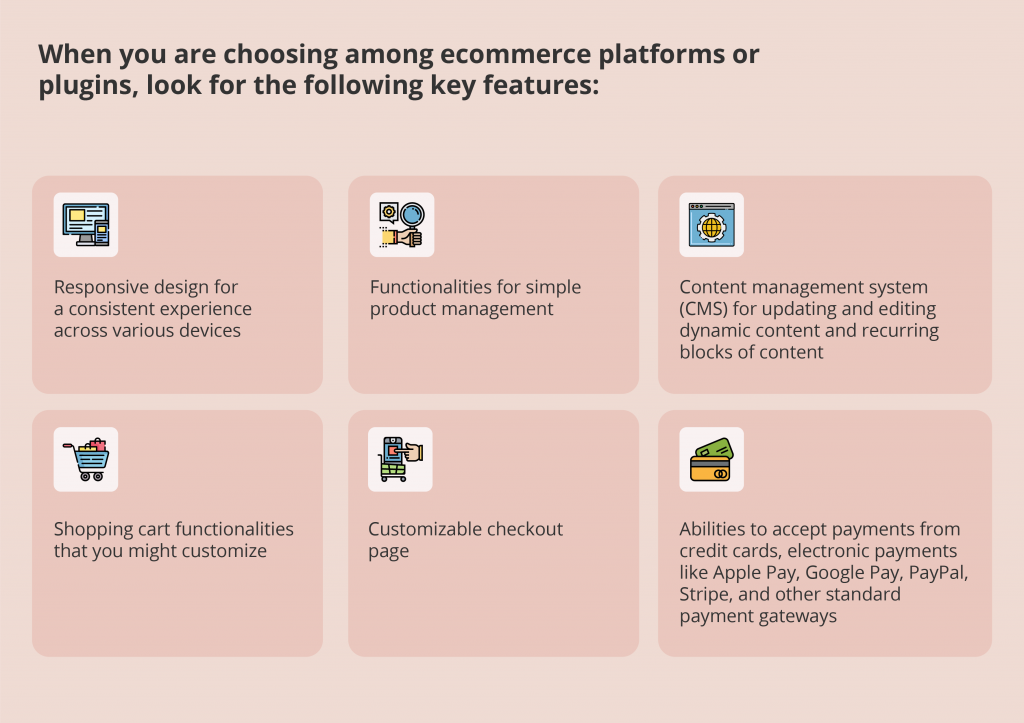
If your business requires a small and simple e-commerce site, a ready-made template costing $1,000 or less can do the job. However, companies that aim at a global arena, vast customer bases, promotion, high revenues, and brand loyalty may have to resort to custom e-commerce web development (albeit it can also use templates).
‘Have to’ because the option implies two significant disadvantages:
- More expensive development
- Longer time-to-market
On the other hand, custom e-commerce development offers:
- Maximum flexibility and control over the UX/UI design, development, and app features tailored to your unique business needs
- Complete ownership of the website code and design
- Capability for easier scaling
- Maximum integration with your business model and marketing strategy
- Ability to create an exclusive look-and-feel of your website across desktop, laptop, smartphone, and other mobile devices
- Ability to handle your SEO needs and other digital marketing parameters as needed
- Easier updates to the system and adoption of new technologies
- Easier website support, bug fixing, and maintenance
- Ability to choose the most suitable hosting provider to sustain your load, so the performance will not depend on third-party software
It’s clear that a custom-built e-commerce web app, with its unique look-and-feel and customized features, will enable you to stand out amongst the competitors and provide better user experiences. This means more conversions, higher customer loyalty, and so forth.
Whether you opt for building an MVP on one of the e-commerce platforms or a bespoke full-fledged online marketplace, your product should include certain e-commerce website features. The following chapter will provide you with a preliminary list.
Essential and Desirable E-commerce Website Features
Let’s start with the functionalities that will be available to your website visitors. The minimum e-commerce features list is likely to include:
1. Login/signup. Users can create an account just by entering their email address or phone number or using Facebook, Google account, or another social login ID.
2. Categories and products. Users should be able to browse by categories, subcategories (if needed), and products.
3. Search. Enable users to search products, filter products by category, price range, and other parameters, and sort by price.
4. Product page. A basic product details page should contain an image, description, and price, as well as an ‘Add to cart’ button.
5. Basic cart management. The items in the cart should be stored on the server. Users will need to add items, change the amount, remove items, and empty the cart. The page should automatically calculate an order’s total cost and shipping costs.
6. Checkout. At checkout, users should be able to access instructions and choose a convenient payment method.
7. Credit card payments. Users should be able to link one or several credit cards to their profile and add and remove them as needed.
8. Order history. The feature is not a mere list of past orders but also the ability to repeat orders.
The system must load fast and be secure, especially when it comes to online payments. Interfaces must be intuitive, neat, and display correctly in all browsers, on all types of screens.
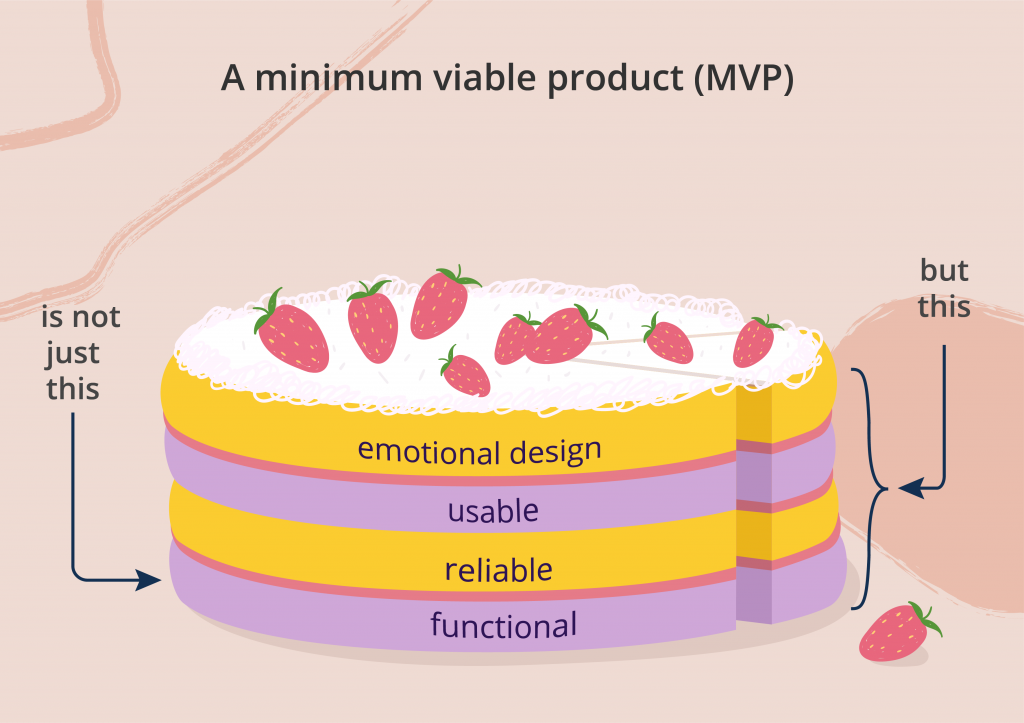
The following ecommerce website features are valuable but might be omitted in an MVP due to time or budget restrictions:
- Subsequent versions can include functionalities related to coupons, promo codes, or vouchers.
- It’s great when users can see an average review on the product page, access more ratings and textual reviews, and post, edit, and delete their own review.
- Product videos are a powerful online selling instrument: they can entice viewers, educate them about the product, and convince them to purchase.
- Product suggestion bar at the bottom of a product page, which shows similar or related products, encourages users to buy more.
- Ability to manage favorite products, brands, vendors, etc.
- Multiple payment gateway options can facilitate more convenient shopping experiences and thus more sales.
- Multilingual support and currency converter will do the same and make your service accessible to more users.
- An incorporated shipment tracking API will enable both the consumers and vendors to follow shipping from the source to the destination.
- Chatbots can assist or substitute your customer service team by responding to the customers’ inquiries about products, orders, and payments 24/7.
The store administrator’s functionalities, inaccessible to consumers, are indispensable for managing your online business. The instruments you are going to use include:
- Content management system (CMS). You will need to create, read, update, and delete (CRUD) administrators and authorize them to access the system, CRUD categories, subcategories, and ordering, CRUD and activate/deactivate products, manage the orders and payment statuses, filter and sort them, etc.
- Customer relationship management (CRM). Such systems help strengthen customers’ associations with a website and improve the customer experience.
- Role-based dashboards. This indispensable functionality is provided by ERP (enterprise resource planning) systems. They facilitate the creation, configuration, and management of custom dashboards depending on the roles for accounting, operations, and other areas of your business. The administrator can monitor and examine various website users, run reports, and adjust the users’ activities to increase their effectiveness and productivity.
- Business intelligence. Modern cutting-edge technologies empower e-commerce owners to store vast amounts of raw data, process it, generate reports, and gain insights into their business and consumers. Having the benefit of various reports, pie diagrams, and live dashboards, the management and administrators can make well-informed decisions.
- Customer behavior tracking. Detailed analysis of the customers’ actions is a significant part of doing business online. A business that understands their browsing, interactions, and other activities on the website can provide more relevant content, offers, and services, improving customer experience and sales.
- Marketing tools. Modern admin panels include various tools for social media campaigns, managing ads and SMS blasts, and so forth. Ecommerce businesses can initiate, coordinate, and track all necessary marketing activities in one place, run various reports, and plan and adjust their sales and marketing strategies for better results.
Once these functionalities have been implemented in the MVP, you will need to select features for future iterations and upgrades. Whatever your decisions, the security, proper performance, user-friendliness, and scalability of your e-commerce solution will remain important.
Quality UI/UX design is essential for an intuitive, smooth, and convenient shopping experience. Along with the strictly utilitarian purposes, online store’s design should build trust and emotional links with the buyers. Hire a professional web designer with a thorough knowledge of modern user interfaces and experience in custom ecommerce design.
Smart innovation can give you a competitive edge. Voice shopping, AI-powered features, and augmented reality (AR) are among the first integrations to consider when online stores want a better customer experience and higher sales.
If you are hiring external back- and front-end developers to implement your selected ecommerce website features, familiarity with some technical terms may prove useful as well. The following chapter lists the most relevant programming languages, libraries, tools, etc. – something to look for in the candidates’ CVs.
Tech Stack for E-commerce Website Development
An online shop’s front-end, the part that shoppers see in their browsers, is created by web designers and programmers using
- HTML5
- CSS
- JavaScript libraries: React, Angular, or Vue
Progressive web apps (PWA) are perfect for e-commerce because they ensure good remote use, faster page loading, even when users are offline, and quick checkout.
The online store’s content is uploaded, orders are processed, and other “inside” things happen in the back-end. The go-to technologies include
- Java
- Python
- Ruby
- PHP
Payment gateways. Payment API integration is essential to any custom e-commerce solution. It’s best to give users a choice by integrating several popular solutions, such as:
- PayPal
- Stripe
- Braintree
- Square
- Skrill
- Authorize.net
- Google Checkout
Shipping modules. These modules are essential for setting up dynamic fees and shopping cart reminders and informing customers on shipping conditions, costs, and other order info. Here, popular services include:
- Shippo
- Sellbrite
- ShippingEasy
- ShipStation
Customer relationship management. Some of the leading CRMs are:
- Microsoft Dynamics
- Salesforce
- Zoho
- InfoFlo
Analytics tools. You may opt for integrating:
- Google Analytics/Firebase
- Flurry
- MixPanel
- Hotjar
- Kissmetrics
- Piwik
Website hosting. If you don’t use a platform with default hosting, you would also have to pick a hosting provider. The most popular and stable services out there are:
- AWS
- Google Cloud
- Azure
- DigitalOcean.com
- Heroku
- hetzner.de
Make sure your choice fits your business in terms of security and performance capabilities, database potential, and compatibility with CMS software.
Security. Your customers’ personal information, banking, and credit card details, as well as your product and price information, need to be protected from hackers and scammers. The techniques to maintain comprehensive security may include, but are not limited to:
- SSL and PCI standards
- web application firewall
- real-time bots
- a proper CRM system where customers’ data can be safe
- guidance for setting a strong user password
SSL certificates encrypt the users’ financial data and other sensitive information. Search engines will also rank a site with an SSL certificate higher. If your chosen hosting provider doesn’t offer this service, you will need to look elsewhere. For example, Let’s Encrypt offers free certificates; DigiCert or Comodo SSL issue paid certificates.
Keep the future in mind. Your site architecture and databases must be scalable to sustain high loads and allow for easy expansion to accommodate your business growth. Cloud infrastructure-as-a-service (IaaS) may provide a solution.

Timeline and Cost of E-commerce Website Development
Words like price, expenses, or budget have been popping up throughout this article. Now, we’ll try to sum things up and answer probably the most vexing question: how much does an ecommerce website cost?
Regarding timelines, a project’s initial stage lasts roughly 2-4 weeks. Subsequent software development will depend on the system’s complexity and other factors. The first version of a basic solution may take from 3 to 5 months, a custom-built online shop – some 4-9 months, and a large e-commerce platform may take a whole nine months and more to build.
Basically, the project budget compounds the hours spent by appropriate experts at each stage of your software development. All of the project stages, choices, and activities mentioned so far both contribute to and can directly impact (increase or decrease) your ecommerce site cost, along with other factors:
- qualification and specialization of the members of your product development team
- size of the team
- type of cooperation (e.g., freelancers, in-house, or remote developers)
- location of the team and individual professionals
- size and reputation of the outsourcing software development company
- whether you opt for templates or build a custom product
- pricing of the preferred e-commerce platform (if any)
- level of customization or complexity of the website design
- scope and complexity of the solution’s functionalities
- intricacy of the e-commerce solution’s architecture
- number and integration of third-party APIs
- urgency and other business objectives
Budget issues are the second major reason why startups fail. An increasing number of companies choose to minimize this risk through a productive outsourcing partnership. Offshore outsourcing helps in saving costs enormously when compared to in-house development or even nearshore outsourcing. Furthermore, it enables entrepreneurs to hire the most suitable experts and promotes flexibility in the business process.
You can outsource your e-commerce MVP development on a fixed-price basis or hire a dedicated team that will be working for you throughout your product life cycle. In any case, the recommended team structure should include at least:
- Project Manager (PM)
- UX/UI designer
- Front-end developer
- Back-end developer
- QA professional
NB. Don’t forget the additional services, such as creating brand identity, graphics, product descriptions, keyword-rich titles, high-quality photos of the products, maybe even short videos, and other content for your website.
Make sure to reach out to at least five development teams and compare their offers. Your essential ecommerce features list can be the basis for the teams’ initial project estimates. The more details you can provide, the more accurate their assessment may be.
A lower quote may not necessarily imply a lower quality of work. The gap in the professionals’ hourly wages in different countries has little to do with differences in training, skills, or experience. Normally, the reasons are purely economic, but the development of the same custom ecommerce solution in the US may cost four times as much as in India.
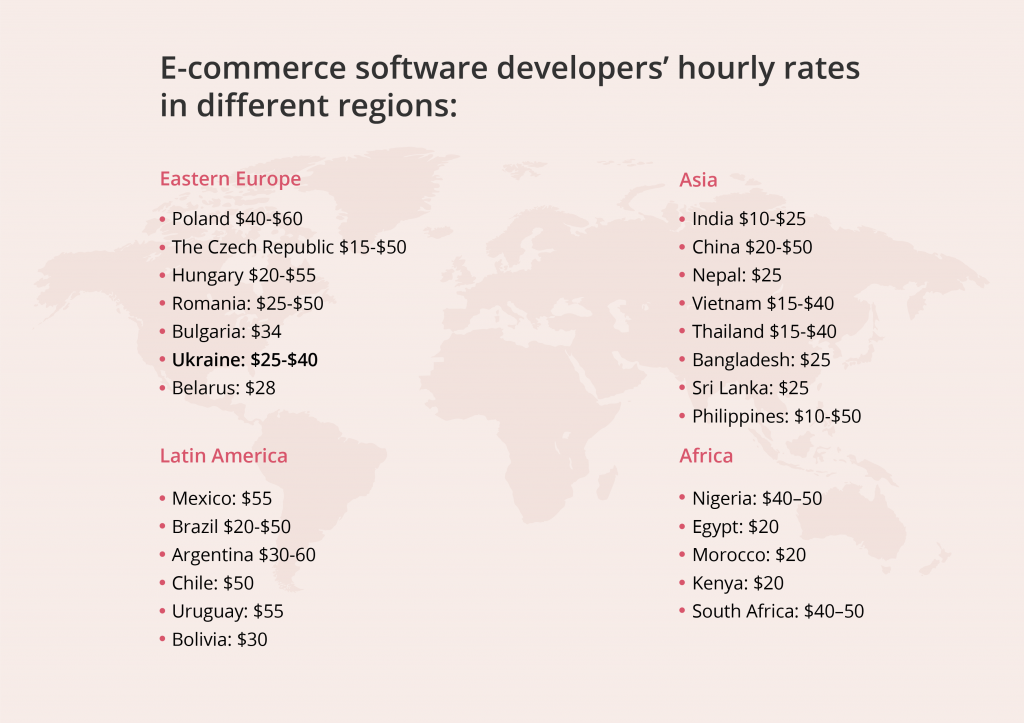
Eastern European IT markets are known for their optimal price-quality ratios. For example, a Ukrainian software developer’s average rate is $25-$40 per hour. This is higher than in most outsourcing destinations in Asia or Africa but still much lower than in the U.S., Canada, or Western Europe.
As a result of all the factors, the cost of creating e-commerce solutions of different complexity, from the initial business analysis to launch to the market, can vary dramatically.
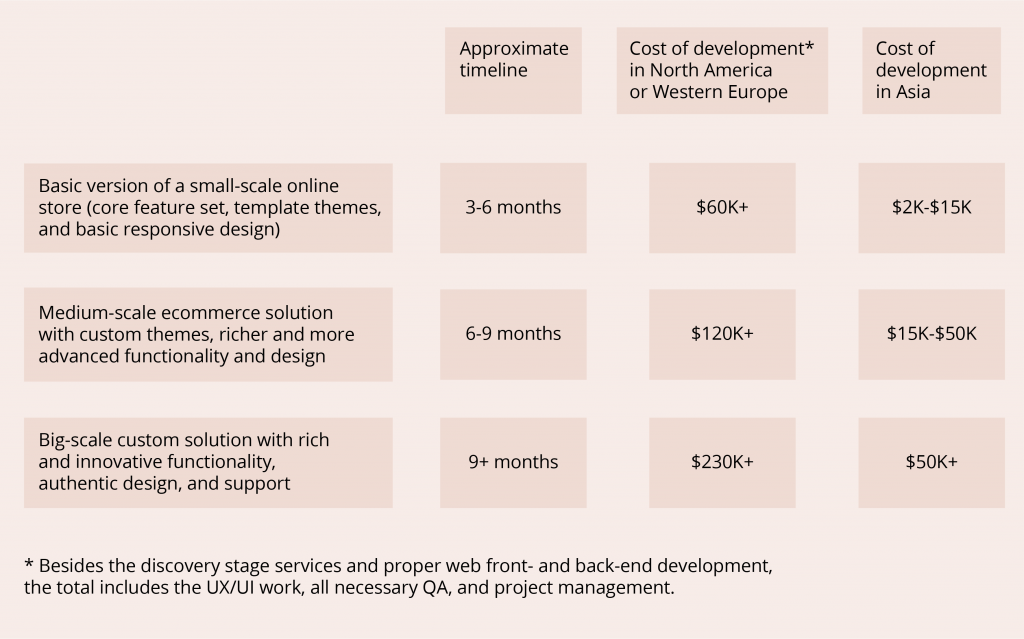
However, this is not all. Ecommerce website development is not a linear process. Once your team has successfully released the first version, the continuous maintenance work starts. Simultaneously, you will need to monitor your customers’ feedback and keep updating and upgrading the website to satisfy the TA’s emerging needs and preferences. The testing of new releases and patching up occasional flaws will also continue.
After your e-commerce website launch, you may still have to pay:
- monthly fees for the server that hosts your site
- annual expenditure on your domain name
- cost of SSL endorsement
The maintenance of an ecommerce website thus may cost from $1,000 to $6,000 per month.
From the project discovery stage through the ongoing support of your online store or marketplace, Alternative-spaces can be your trusted outsourcing partner. Our employees possess a thorough knowledge of the e-commerce industry, the most popular and emerging applicable technologies, and excellent user experience and modern online shopping interfaces.
We have vast experience in building custom e-commerce solutions for international clients. Our development process combining the Scrum framework and the Lean Startup approach promotes flexibility and facilitates quick implementation and testing.
Whether you would like to test the water with a minimum viable product using templates, or are about to build something groundbreaking from scratch, please feel free to reach out. A 30-minute talk will be enough to decide how your project should proceed.
Content created by our partner, Onix-systems.
 Home
Home